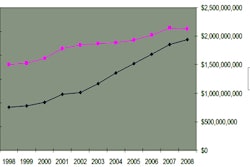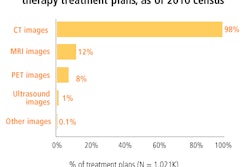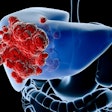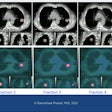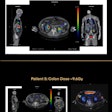In a U.K. study evaluating dry mouth toxicities, intensity-modulated radiation therapy (IMRT) proved to be far less debilitating for cancer patients than conventional radiation therapy. Results were published online January 12 in Lancet Oncology.
The randomized phase III PARSPORT trial included six U.K. cancer treatment centers participating from 2003 through 2007. The study was designed to determine if reduced irradiation of the parotid glands using IMRT could lower the incidence of severe xerostomia in patients with squamous cell carcinoma of the head and neck, compared to treatment with conventional radiation therapy.
Investigators reported that at a median follow-up of 44 months, the percentage of patients with grade 2 or higher xerostomia side effects was significantly lower in the group of patients who received IMRT.
A total of 94 patients were enrolled in clinical trial: 47 patients for each treatment arm. All patients received 65 Gy in 30 daily fractions delivered over a six-week period. More than 80% in the total group were experiencing grade 2 or higher xerostomia three months after treatment. However, this toxicity had declined significantly one and two years after treatment for the IMRT group.
Cases of xerostomia by treatment modality
|
Principal investigator Christopher Nutting, MD, a consultant clinical oncologist and head of the head and neck unit of the Royal Marsden Hospitals NHS Foundation Trust in London, and colleagues also recorded salivary flow in 80 of the patients prior to treatment. Fifty-nine patients were evaluated one year following treatment, and almost half of the 34 patients in the IMRT group had unstimulated saliva flow from the contralateral parotid gland. However, none of the 25 patients in the conventional radiation therapy group experienced unstimulated saliva flow.
Thirty-one patients were evaluated two years after treatment. Again, none of the patients in the conventional treatment group, a total of 15, had unstimulated saliva flow, whereas seven (44%) of 16 evaluated IMRT patients did.
Patients in the IMRT group experienced more fatigue than their counterparts, a side effect attributed to greater radiation dose to nontumor tissues. At two years, no significant differences were seen between the two groups in nonxerostomia late toxicities, locoregional control, or overall survival, the research team reported.
By Cynthia E. Keen
AuntMinnie.com staff writer
January 18, 2011
Related Reading
IMRT reduces dry mouth toxicity, June 2, 2010
Adverse effects common with chemoradiation for head and neck cancer, December 22, 2009
Acupuncture associated with neuronal activation and physiological responses, August 28, 2008
Copyright © 2011 AuntMinnie.com





